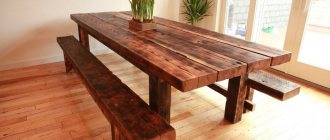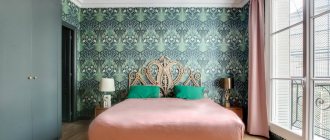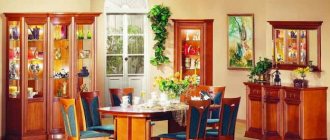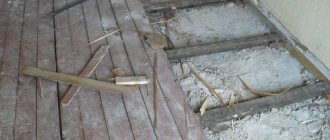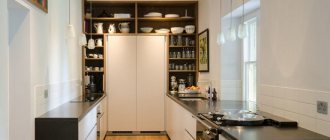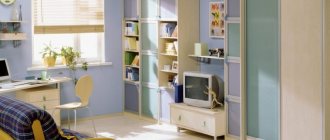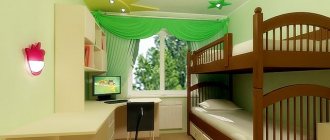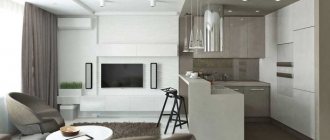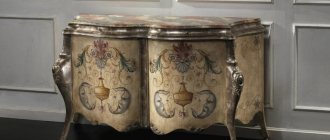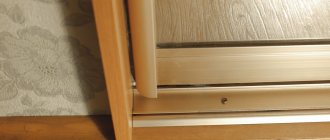We restore an old cabinet: repainting, aging, decoupage
Before you start working, you need to figure out (or better yet, sketch in color) what the finished product will look like. Having considered this point, you can begin purchasing the necessary materials. We will need:
- synthetic paint brushes of medium hardness (one for paint and one for varnish - at least two centimeters wide);
- wood paint;
- sandpaper (harder and finer);
- water-based varnish for wood (matte or glossy - at your discretion);
- acrylic primer for wood;
- masking tape;
- paraffin candle;
- napkins for decoupage or drawings printed on thin paper;
- PVA glue;
- spray bottle with water.
Pneumatic airbrushes, spray guns, texture guns
Step-by-step instruction
Step 1. First of all, you need to remove all the fittings, and you need to start work by cleaning the surface of the cabinet from old varnish. To make the work go faster, it is better to use a sander, but if you don’t have one, you can sand the cabinet manually.
To treat the surface of the wardrobe, a small round nozzle is enough
Step 2. The entire surface of the cabinet that is planned to be painted must be coated with a primer. You need to apply the composition with a brush in one layer, and then dry for the time recommended by the manufacturer (usually the primer dries for at least three hours).
The primer is usually colorless
Step 3. Cover with masking tape the parts that we do not plan to paint. We paint the remaining elements with a brush in one layer. Leave to dry, then, if necessary, cover the surface with a second layer of paint.
The first layer can be applied with white paint, the next layer is colored.
Step 4. Apply paraffin. We need to use a paraffin candle to treat those areas that we plan to make aged (for example, the side edges). This technique will allow you to remove part of the paint layer and expose the previous one. This achieves the “scuffed” effect that is relevant for old furniture.
Paraffin should be applied in a fairly dense layer.
Step 5. Next, the cabinet needs to be covered with another layer of paint - this time it should be slightly lighter than in the previous layer (you can add white paint and stir). Doors and protruding elements can be painted in a different shade or color if desired, after sealing the joint lines with masking tape.
Strips of tape will allow you to draw even boundaries between shades
Step 6. We decorate individual elements (in our case, drawers and door ends) using the decoupage technique. To do this, apply a napkin with a pattern to the surface of the cabinet, moisten it with water from a spray bottle, then smooth it with a brush. Afterwards, cover the napkin with a layer of PVA glue and wait for it to dry.
PVA glue dries in about 20-25 minutes
Step 7. We varnish the finished cabinet in two layers (each layer must be dried according to the instructions).
Result of work
Assembling the buffet body
1. Finish sand the inside surfaces of the top and bottom panels A/F/G, rear wall B-E, side frames H/I/J and front pillars K, gradually reducing the abrasive grit to No. 220.
2. Dry (without glue) connect the top and bottom panels A/F/G. rear wall B-E, side frames H/I/J and front pillars K (Fig. 1). Mark the boundaries of the intersection of the body elements on the inside to protect the gluing points before applying finishing compounds (photos D and E). The rear and side walls are glued to the rear and end edge trims F, G of the top and bottom panels, and the front posts K are glued to the front trims G. 11-mark these areas that should not be exposed to finishing compounds (Fig. 1).
3. Apply the finish to the interior surfaces of the top and bottom panels A/F/G, rear wall B-E, side frames H/I/J and A-pillars K. We first applied a coat of linseed oil, followed by three coats of clear spray varnish balloon.
4. Connect the rear wall B-K, the side frames 1I/I/J and the front pillars K (Fig. 1).
Quick tip! Mounting squares pressed with clamps inside the rear corners of the case will help achieve squareness during assembly.
Temporarily place the top panel A/F/G on top and mark the centers of the slats (photo F). Then temporarily place the assembly on the bottom panel and also mark the centers of the sockets.
5. Mill out the slots for #10 slats according to the marks you made. Apply glue, insert slats and connect the B-E/H-K assembly to the top and bottom panels. Secure the housing with clamps and check the squareness.
Decorative elements
If the main covering of the buffet is in good condition (or, for example, you want to preserve the charm of antiquity, while only slightly updating the appearance of the item), you can add various decorative elements. The easiest way is to apply designs on the doors or walls of the buffet. For this, it is most convenient to use ready-made stencils (even a person who does not have any special talent for drawing can use this method).
However, some rules must be followed:
- Clean the area where the design is applied from dust and dirt, and coat with varnish.
- Place the stencil in the desired location and secure it.
- Dilute the paint to medium thickness (too thick or liquid composition will not work).
- The coating must be applied with a sponge in a thin layer 1-2 times.
- After the paint has dried, cover the finishing area with protective varnish.
Buffet in the interior
A sideboard cabinet can be chosen for the kitchen, living room, dining room, provided that the rooms are spacious enough. The installation location leaves an imprint, which is expressed in the design features.
- The kitchen model is the central design element. It is best to install it opposite the doorway or near the dining table. For this room, you should prefer a model without open shelves, made from materials resistant to changes in temperature and humidity, and a large countertop.
- In the dining room, the buffet for dishes is placed against the wall, but in such a way as to ensure the minimum possible distance to the table. The design with glass facades will allow you to admire beautiful objects while dining. A small tabletop is sufficient for serving.
- The living room often performs the same functions as the dining room, so the principle of choosing a place is similar. Sometimes a pantry cabinet serves as a kind of showcase. On glass shelves, in addition to guest services, you can place collectibles. Lighting and a mirror instead of the back panel will enhance the decorative effect.
From an old sideboard - an “antique” sideboard
Antique furniture is always in fashion - it adds an aristocratic touch to the entire interior. It’s nice that this technique can be done with your own hands, which means it’s cheap. There are several techniques for artificial aging, choose the one that suits you best.
Method 1 – craquelure varnish
Additionally, you should purchase craquelure varnish in specialized stores; all other materials were described above.
Description of works:
- After removing the old coating and sanding with sandpaper, apply a special craquelure varnish to the surface. It has the ability to transform the entire surface into a canvas cracked, as if from old age;
- After the previous composition has dried, you need to apply paint or clear varnish to the surface of the sideboard.
After all the procedures, you will receive an “antique” sideboard in a surprisingly short time. It should be noted that using paint in this method is more preferable - the effect will be brighter.
Method 2 – mechanical aging
For this method, you need to prepare two stains on different bases, a shellac primer and restoration wax.
Description of works:
- after cleaning the old varnish or paint, apply water-based stain as a base;
- lighten with a moistened sponge those places that are more visible;
- after drying, you need to sand the areas that will be darker;
- now apply the stain again with a different base;
- After the second layer of stain has dried, fill all places with shellac primer using a brush;
- using a wire brush, rub in the restoration wax, moving it along the fiber;
- After the wax has dried, wipe the sideboard with a soft cloth;
In fact, there are many more ways to age. Uniquely beautiful masterpieces are created using the “shashel” method, but this can be done by those who are familiar with carpentry.
Step-by-step instruction
When moving on to the actual implementation of restoration work, you should follow consistent instructions. This will help you carry out the restoration correctly and avoid common mistakes.
We disassemble and remove all removable parts
To make restoration of the sideboard easier, it is recommended to disassemble the product so that each part can be processed separately. When disassembling, you should remove all parts, remembering their location for further reassembly in reverse order.
Shelves
As a rule, the shelves in the buffet are not held in place by fasteners and are located on several metal parts that are built into the walls. With this design, it is enough to lift the shelves and pull them out of the sideboard.
Accessories
You can unscrew the fittings using screwdrivers. To restore the appearance, repair or replace, remove hinges, door handles, legs and other elements.
Glass
To avoid breaking the glass inserts in the sideboard during restoration, you must first remove them. If the glass is inserted into wooden frames, it is easier to remove them completely. In situations where individual glass elements cannot be removed, they are covered with paper or masking tape.
Cleaning old coating
Having dismantled the buffet, they began to process the old coating. You can remove the top layer using a spatula or a special furniture scraper. Then the surface is rubbed with fine-grained sandpaper so that the wooden pile does not create problems when degreasing and applying paint. The polished elements, as they are processed, are removed to a clean place for further stages of restoration.
Washing and degreasing
After cleaning the old coating, the parts of the sideboard are shaken off dust and degreased. To effectively degrease the surface, you can use white spirit or regular alcohol. After applying the product you need to wait for it to dry.
Puttying
The degreased parts of the sideboard are inspected for delamination and unevenness, after which the cracks are puttied. When performing work, the following recommendations should be taken into account:
- the width of the spatula should be slightly larger than the crack or unevenness in order to cover the defect in one movement;
- Before direct use, the putty must be thoroughly mixed;
- if the gap on the wooden surface is too deep, it is better to fill it with putty several times, allowing each previous layer to dry.
The puttying process itself is simple: apply a sufficient amount of the mixture to the spatula, and then, pressing it to the surface, make a downward movement. An additional movement is necessary to remove excess material if it remains.
Grinding
The use of an automatic grinding machine allows you to speed up and simplify the work process. Work should be carried out in a garage or outdoors, since sanding produces a large amount of waste, including dried paint, dust and pieces of varnish.
Padding
The following types of primer can be used to treat a wooden sideboard:
- Alkyd. Used if the wood has not been pre-treated. The primer allows you to make the surface smooth and even. Drying time is 12-16 hours.
- Polyurethane. The composition is based on polyurethane synthetic resins, solvent and tonic additives. The material is suitable in cases where it is planned to cover the sideboard with parquet varnish.
- Silicone-acrylic. After applying this type of primer, the wood becomes more resistant to fluctuations in atmospheric humidity.
- Aerosol. It differs from other varieties in the way it is used. If in other cases you need to use a brush and roller, then here you will need to spray the structure. The advantages are the ability to treat hard-to-reach places and quick drying.
Painting
It is better to start painting with the main surfaces of the buffet, and then move on to the decorative elements. As a rule, the paint is applied in two layers, but if you want to leave the visual effect of aging wood, one thin layer will be enough.
Decoration
There are several options for decorating a prepared wooden surface. Using various techniques allows you to change the appearance of the sideboard and make it more sophisticated.
Decoupage
Decoupage involves decorating wooden surfaces with decorative appliqués using napkins with images. Drawings are cut out from napkins and transferred to wood. The surface is then covered with acrylic paint and varnish to preserve the design.
Buffet - design features
A sideboard is a furniture product of a combined type. It can be recognized by a number of characteristic features.
- The design consists of three sections: lower, upper and middle.
- The tabletop is located in the central part at a convenient height.
- The model has significant height and width.
Such a cabinet has a practical and decorative purpose.
The closed lower compartment is used to store large and heavy items:
- pots;
- frying pans;
- household appliances;
- grocery supplies, etc.
The drawers are occupied by cutlery and textiles (towels, napkins, tablecloths).
At the top there are beautiful sets, decorative plates, and glasses. The shelves are left open or equipped with doors with glass inserts.
The middle part is a niche with a working surface. If the buffet is narrow, then to increase it there is a retractable tabletop. This part usually contains spices, a bowl of fruit or pastries. The horizontal surface is used for cooking and serving.
The benefits of making it yourself
If a home craftsman is comfortable with carpentry tools, it will not be difficult for him to please the housewife and make a buffet with his own hands, which is necessary in any kitchen.
For maximum convenience and comfort, you should equip it with not only beautiful, but also functional furniture, such as a buffet.
An excellent solution for any home is to install a corner kitchen cabinet.
A self-made kitchen cabinet has a number of advantages over its “store-bought brothers”:
- you can choose a unique design for it;
- choose the material to your liking;
- use original fittings;
- choose the color scheme of the buffet that best matches the kitchen interior.
To make the interior original, you can make it yourself, putting your soul into the work, using any materials.
The most important nuance when installing such a cabinet is calculating the trajectory of the door opening.
In addition, wood products are extremely beneficial for health: they do not contain toxic compounds and do not emit harmful substances, but they fill the room with the aromas of essential oils.
Sideboards and buffets for the kitchen do not have much difference and are very similar in appearance to each other, because... The ancestor of both is considered to be the closet.
A kitchen buffet is an excellent solution for your kitchen interior.
A wooden sideboard is durable and comfortable. It will last for decades and is easy to restore and repair.
A sideboard made of natural wood will look rich and elegant, but at the same time it will cost a much larger amount.
Another important advantage of making a kitchen cabinet with your own hands is the ability to make it in an original configuration and size that best suits convenience and comfort.
To get a beautiful product without spending too much, you can make the furniture body from cheaper raw materials, such as chipboard, and the facades from more expensive and beautiful ones.
Necessary materials
In the friendly family of kitchen furniture, the sideboard occupies a special place - it reigns in the kitchen and bears the features of an elegant sideboard and an ordinary cupboard. Previously, furniture was made “to last,” so the most durable and high-quality wood, well-seasoned and processed, was chosen for its manufacture.
This furniture option is practical, beautiful and takes up little space.
Today's offer of building materials allows you to choose the necessary option for making a buffet with your own hands. But one of the most popular bases for kitchen furniture has become MDF, fiberboard, chipboard and solid wood. The latter does not require additional characteristics, being distinguished by strength, durability, and beauty. As for wood boards, each of them has its own effective properties and disadvantages.
- Fibreboard is resistant to moisture and temperature changes. It is light, strong, durable, affordable and not difficult to process. A buffet made from this material can be quickly assembled. It can be made functional and visually attractive. Most often, such plates are used to install the back walls of wall cabinets, drawers and shelves.
- Chipboard is available in a variety of colors. This is a durable and inexpensive material from which you can make a comfortable, spacious and original cabinet that can easily fit into any kitchen interior. Among the significant disadvantages are emissions of formaldehyde into the air. To reduce their harmful effects on human health, it is necessary to place furniture made from chipboard away from heat sources.
- MDF is used quite widely today. It is manufactured using modern technologies, therefore it is an environmentally friendly material. It has high moisture resistance, which makes it more suitable for use in the kitchen. It has a soft, easily processed structure, which allows it to be used to create a variety of decor for furniture fronts of buffets and to give products a variety of shapes. The only drawback is the fairly high price compared to the cost of chipboard.
- Solid wood is a special chic and a demonstration of high taste. Environmentally friendly, natural material.
- pine, durable and easy to process;
- larch, strong and not subject to the destructive effects of moisture;
- oak, practically eternal, does not rot and does not require varnishing.
This means that you will simultaneously receive moral pleasure from the work done, even if it seems somewhat labor-intensive to you.
The following tree species are most often used to make buffets:
Kitchen cabinets can only be appreciated by true connoisseurs of beauty and art.
Depending on the place where the hand-made buffet will be installed, you can use different materials. For a dacha or summer kitchen, you can make a kitchen cabinet made of plastic, simple in design and inexpensive.
After all, with the help of this product you will be able to restore order in this part of the house, and it will become the “highlight” of the interior.
An original sideboard in a mansion kitchen, made of MDF or solid wood, with unusual shelves and niches, will look expensive and presentable.
Today, a buffet is a kitchen cabinet, which is completely closed at the bottom, and its upper part is made in the form of a display case.
Decoupage of an old sideboard - the atmosphere of Provence
To perform decoupage you will need to supplement the list of materials and tools.
Materials for decoupage:
- new “antique” handles and door hinges;
- napkins for decoupage;
- PVA glue;
- White paint;
- furniture varnish;
- sandpaper;
- stain;
- wood putty;
- metal brush.
You can buy napkins for the decoupage technique at a craft store. Choose those that you like, but in a floral theme of blue, lavender or burgundy. If you have chosen furniture handles with ceramic inserts, then this pattern should be in harmony with the image on the decoupage napkins. We dealt with the old coating in the previous sections. In addition, you need to replace all the old hinges for the doors, repair skewed drawers, and also make other repairs, if necessary.
Let's get started with a step-by-step description of how to decoupage a sideboard with your own hands:
quickly wipe the entire surface of the sideboard with a damp cloth so that no moisture is absorbed;
cover all cracks with wood putty;
go over the entire surface with sandpaper, removing all defects;
cover the wood with stain and let it dry;
now is the time for a unique aging technique - apply wax to all corners, drawing on them with a wax candle;
coat the sideboard twice with white paint, however, all pale pastel shades are well suited for Provence, especially mint and lavender;
After the paint has completely dried, remove the wax by carefully manipulating it with a metal brush. This is a simple and effective technique for simulating antiquity;
We coat the napkins with PVA glue and glue them to the lower or upper doors, carefully smoothing them out to remove air bubbles;
To make the glue work faster, direct a stream of hot air from a hair dryer at it;
Cover the decoupage areas with clear varnish. Do the same with the aging areas.
The new Provence style sideboard is ready, the only thing I would like to add is that if there were glasses in the sideboard, they can either be painted over or replaced. And, of course, don’t forget to place a bouquet of lavender in a white ceramic vase on it.
Where to put the buffet
The problem of many housewives who own a useful and functional buffet is: where to put it in the kitchen? In this matter, it is better to trust the professionals - designers take into account all the available nuances when placing furniture (room area, location of the furniture, distance from sources of water and fire, etc.).
Sideboards made from solid wood are not only heavy, but also look more solid compared to their counterparts made from MDF, chipboard and fiberboard. Therefore, the placement of an oak sideboard must be thought out in advance; subsequently, moving the cabinet with dishes will be problematic.
Plastic sideboards are lightweight, but are not in wide consumer demand; most often such furniture is purchased for country houses or summer kitchens. For many people, a buffet is a symbol of antiquity and a certain massiveness. Manufacturers of combined sideboards equip a frame made of any type of slab with an elegant and functional facade. This makes it possible to reduce the cost of the finished product and create a lighter product.
To save space, designers sometimes suggest building a buffet into a kitchen set. This will create a single furniture ensemble; all the necessary little things (dishes, seasonings, recipes, etc.) will always be at hand for the hostess.
The buffet should be placed on some wall. It is not recommended to install a large cupboard in front of a window or in front of a door; this will create inconvenience during its operation and will reduce the intensity of natural light in the kitchen. A gloomy room is completely unsuitable for cooking and eating food.
When buying or making a sideboard for the kitchen, the master must take into account the color schemes and style of the rest of the kitchen furniture. In a classic country-style kitchen, a corner black sideboard will look ridiculous, which will create discomfort in the perception of the interior.
Important: the internal shelves of the buffet can be decorated with additional lighting by attaching an LED strip. This will add charm and practicality to the finished product.
Wood is a unique material that is great for decorating various rooms. Not only is it of natural origin, but it also does not emit any toxic substances, but on the contrary, it enriches the air with essential oils. Perfect for making various furniture. It is distinguished by strength, aesthetics, practicality, environmental friendliness and durability.
Interior items made with your own hands increase the value of such items and make them unique. They bring comfort and warmth to the room, and delight the owner's eyes. This also allows you to bring even the most daring ideas to life. All you need is a little patience, wooden boards and tools that can be found in almost every home.
Required Tools
Before you begin restoration work, you should prepare the tools that will be useful for processing a wooden surface. Having the right list of tools at hand, you will be able to quickly complete the job without being distracted by searching for equipment.
Furniture scraper
A metal scraper is often used instead of a spatula to remove paint coatings. The tool effectively cleans the surface of excess paint, grout, adhesives and polyurethane foam. The presence of a rubberized handle with a textured coating makes the scraper easy to use. The fastening mechanism ensures strong fixation of the specially sharpened blade.
Foam sponge
Thanks to its high density polyurethane, the sponge helps remove dirt from any surface. It is better to purchase a foam sponge with a large area to speed up the process of cleaning the sideboard. This type of sponge has the following advantages:
- absorbs water and cleaning agents well;
- forms a copious amount of foam;
- does not leave fibers or streaks;
- It is easy to wring out and dries quickly.
Brush set, water-repellent varnish
To paint a wooden surface, you need brushes of different sizes. Large brushes are used to paint the main area, and small brushes are used for hard-to-reach areas. After painting, a water-repellent varnish is applied to the sideboard.
Wax, stain or acrylic
These products are used to restore the shade of wood and improve the appearance of the sideboard. Of the proposed options, oil-based stain is most often used, which allows you to make the color of the wood as natural as possible. The stain is absolutely safe for human health and the environment, dries quickly and protects the surface from destruction.
Wood clamps
A clamp is a device with a clamping mechanism for holding products during processing or when gluing individual parts. Using clamps, the tree is secured in a stationary state, which simplifies further work. The design of the clamps includes an F-shaped frame or brackets
Also an important component is the moving part, which compresses or releases the fixing elements. The moving element is activated by force
Glue, high-quality nail polish remover
You can remove the old layer of varnish using a special solvent, which is sold at any hardware store. Glue will be needed in situations where the sideboard has begun to delaminate or some decorative elements are not securely fixed.
Accessories
Door hinges and sideboard handles wear out over time, no longer properly fulfill their purpose and lose their original appearance. During restoration, the fittings should be replaced by purchasing new sets.
Electric jigsaw
Using a jigsaw, you can cut wood and make curved cuts without much effort. Modern types of tools are equipped with speed controllers, noise and vibration dampers. For safety reasons, there is a protection above the support saw of the electric jigsaw that protects against accidental contact with the sawing element.
Marker
You can apply markings for cuts and installation of decorative elements using a marker. It is better to use a permanent marker so that the applied markings are not erased during the work process.
Fasteners
Fasteners are used to secure the top of the sideboard to the base. You can also use wall fasteners to secure the buffet in one place, ensuring it is stable and immovable.
DIY buffet restoration
Most of the good old furniture from Soviet times was taken to the dacha in the 70s and 80s. To put it mildly, it was not used carefully. Carved sideboards, oak, walnut, antique and 60s, rustic, white painted, with mirrors and stained glass just beg to be put in order with your own hands.
How to restore old furniture with your own hands
1. Decide. Why is this being done? What should happen?
2. Assess the depth of damage and your strength. Will you do this in an equipped workshop or at home?
This is especially important when choosing varnish or paint, solvents and cleaners
3. Draw up a work schedule.
4. Carry out work in strict sequence: clearing, carpentry, finishing. Usually this is done the other way around. First they paint, and then it turns out that the veneer has lifted, the paint or varnish did not lie evenly on the old coating. A layer of white paint does not hide dark spots. No matter how much you paint, they still show through. There are cracks on the walls that became more noticeable after painting in light colors. The wood has been eaten away by furniture beetles. The antique mirror has become tarnished, which was not noticeable under a layer of dust before. A couple of legs are missing...
It is imperative to restore old furniture with your own hands (restoration refers to a set of actions to preserve the item). Try new materials, study technologies, analyze mistakes, go towards the goal. Perseverance and perseverance are the foundation of success.
If you have any questions about the restoration of an antique sideboard, sideboard, table, cabinet, antique chair, sofa, or any other antique furniture, please ask questions by phone or via our email.
Estimated cost of restoration (price as of January 9, 2019)
| Price, rubles | |
| Chair | 5000 — 20000 |
| Armchair | 10000 — 30000 |
| Sofa | 30000 — 60000 |
| Cost, rubles | |
| Table | 10000 — 40000 |
| Buffet | 30000 — 80000 |
| Closet | 30000 — 80000 |
Restoration of paintwork
By sending us a completed form with photographs, as well as asking a question, you will receive complete information about the item (what it is, material, age) and the cost of restoration work. Next, the restorer will come to the site, inspect it, and determine the final price of the restoration.
The final price will not change. Departure is free.
How to make a wardrobe or chest of drawers from a sideboard
The difference between a wardrobe and a sideboard is, perhaps, not so much external as functional.
A sideboard is usually understood as a cabinet in which dishes and kitchen textiles are stored. Personal belongings are stored in the closet. The top doors of sideboards traditionally have glass. The bottom of this piece of furniture consists of drawers. Cabinets are often made entirely of wood, although glass and stained glass are also used here.
- If you need to convert a sideboard into a cabinet, you can replace some of the glass elements with wood, or made of plywood, chipboard, etc.
- Another option is to transform the glass from transparent to colored and non-translucent using a special film.
- Also, most likely, you will have to change the color of the sideboard so that it fits seamlessly into the living room.
- It’s not uncommon lately to see master classes on converting old unnecessary sideboards from the Soviet era into multi-colored cabinets for children’s games.
- The chest of drawers is a vertical series of drawers. It is installed in bedrooms and living rooms, allowing you to store personal items and clothing out of prying eyes. If the lower part of the sideboard consists of drawers, depriving this item of the top, you can get a chest of drawers. In some furniture models, individual elements can be detached from the overall structure without problems, in other pieces you will have to use a saw.
So, as you can see, there are many ways to give old furniture a second life. The main thing is to have a desire to work with your hands, as well as a good imagination.
Are you wondering how to make a cabinet out of a sideboard? Then watch the following video, where a wardrobe will be made using the example of an old sideboard-chest of drawers:
https://youtube.com/watch?v=XDdWusGHOqE
Buffet decoration
The final stage of making a unique kitchen cabinet, made by yourself, will be its decoration. Here can be used:
- ready-made fittings;
- handmade wooden or metal decorative items;
- ornaments and colored decoupage images;
- photographs, glass and plastic decorations;
- original decorative products, made by hand or to order, depending on the style of the product.
To assemble furniture you will need a lot of space, so before you make a cupboard with your own hands, you need to take care of the free space.
Due to decorative elements and the use of natural materials, cabinets are most often used in a classic style.
Restoration of wooden furniture. 12 cool ways to update old furniture.
Old furniture can be slightly changed in appearance and then it will fit perfectly into your intended interior.
What ways are there to update furniture?
1. Decor with paper.
Do you want to change the color of your furniture to an unusual, non-standard one? Old wallpaper and pieces of beautiful paper are perfect.
The paper is glued to the cleaned surface of the object using PVA glue or wallpaper glue.
The principle is the same as when gluing wallpaper - after applying the glue, leave the paper for a couple of minutes to get wet
It would be a good idea to update the furniture in the nursery using old maps.
The idea, by the way, is very popular.
Remnants of wallpaper and beautiful paper are also suitable for decorating furniture.
Great idea to update the sides of the drawers with paper. It turns out quite original.
2. There are ready-made stickers - sticky paper. With its help, you can update the surface of furniture with unusual patterns.
Old furniture is often updated with regular vinyl film.
People with imagination get creative with film. One drawback is that if it is not glued correctly, the film is short-lived in use.
But the film is good for beginner furniture renovators; it will cover all the imperfections and cracks.
There is a film with figures of various animals and flowers. Typically this film is used for a children's room.
3. Decorative elements.
If the furniture is boring, you can decorate it with plastic elements that are sold in construction or art stores.
You can also cut the elements out of plywood with a jigsaw if you don’t find any ready-made ones for sale.
4. Decor with fabric.
Furniture is still decorated with fabric today.
There is also a new technique for working with fabric, Patch decor.
Pieces of fabric soaked in PVA glue are used to paste furniture in different orders in the Patchwork style.
Patch decor uses not only fabric, but also various elements made of fabric and cord.
Buffet formats
Before you open your buffet from scratch, you need to decide on its format. They are conventionally divided into morning, lunch and evening - according to peak load time. Theoretically, a small establishment selling simple food can be located anywhere: in a school or business center, in a football or hockey arena, in a hospital or factory, in a hotel or in court. However, some formats are most popular due to their profitability and prevalence.
Type: Restaurant (dining room)
Features: In large catering establishments, you can open a small buffet. It is designed for those who want to have a quick snack or buy groceries at a lower price. In this case, several issues are resolved: there is no need to look for a supplier of products, or additionally organize cleaning of the premises.
Type: Student (school)
Features: An establishment of this type does not have the right to sell alcohol, and the sale of dishes and snacks, as a rule, is carried out using disposable tableware. Schools do not encourage the sale of potentially unhealthy food (chips, popcorn, sweet soda). Students need vigor and health to work productively, therefore, in addition to hot food, it is recommended to replenish the assortment with fresh vegetables and fruits, and energy bars.
When opening, you should take into account the height of visitors: the counter for paying the bartender and receiving the order should not be too high. Students away from home mostly eat lunch or have a small snack, which needs to be kept in mind when preparing the menu. The greatest flow of visitors is achieved at lunchtime, it is important to organize very fast service.
Type: Office (in a business center)
Features: An adult, solvent and discerning audience has appropriate service requirements. To be popular, a catering facility must have an impressive assortment and conditions for eating food (not only a counter, but also normal tables and chairs). It is important to create an attractive design for the establishment and strictly adhere to the dress code for the seller.
In the office buffet, visitors mainly have breakfast, go for lunch (work break), and have lunch much less often (if there are enough canteens, cafes and restaurants in the vicinity). It is necessary to create conditions for the sale of takeaway hot drinks and alcohol, which is extremely in demand in the business environment.
Type: Hospital (outpatient)
Features: In health institutions there is also a high need for catering establishments. The facility does not have to rely on the sale of alcohol and cigarettes, which is due to the specific location. It is important to ensure high sterility: the presence of disposable tableware, frequent wet cleaning of tables, counters, floors, and a wide range of packaged food products.
In a hospital or clinic, the buffet is mainly used for snacks; it is unwise to rely on hot breakfasts, lunches and dinners. Taking into account the characteristics of the healthcare institution, it is important to adjust the work (for example, from 7 or 8 in the morning until the evening).
In addition, there are buffets in theaters, industrial enterprises, and government agencies. However, establishments of this type suffer from excessively low occupancy (for example, only on days when productions are shown and only at certain hours), and rarely demonstrate high profits. But if it is possible to create a catering outlet that can accept customers “from the street” (that is, through a window for dispensing goods), then it makes sense to consider theaters, enterprises or government agencies as a platform for business.
Beautiful examples
This photo shows a buffet restored in the Provence style using decoupage. The combination of two non-standard colors (lilac and pale green) creates the effect of ease of perception. This color scheme has a positive effect on the mood of the beholder and evokes a positive emotional response.
Here is a sideboard that has been restored while maintaining the natural wood tone. This solution makes it possible to bring its visual design closer to the original and helps the observer to feel the presence of antiquity. A similar effect is achieved thanks to the tinting paint coating and darkening the protruding parts.
Removing chips and cracks
Therefore, if you are not sure that you will be able to carry out repairs at home, it is better to contact a specialist.
If you decide to do it yourself, you need to stock up on the necessary minimum tools:
- White spirit (nail polish remover);
- Stain of the desired shade;
- Wood primer;
- Fine sandpaper (100, 180, 300, 800, 1200 and 3000);
- Wood putty;
- Masking tape;
- Roller or brush.
Clean the damaged area from the varnish coating using white spirit, treat the wood with a primer, then putty.
After drying, level the putty with the surface using sandpaper. Remove dust with a damp cloth and apply stain to obtain the desired shade.
It is important to apply the stain exclusively to the putty area, without getting it on the wood. Otherwise, the wood will change color, and then major repairs will be impossible.
After complete drying, you can varnish. The varnish should be applied with a brush or roller, depending on the area of the area.
Each new layer can be applied only after the previous one has completely dried and preliminary sanding with sandpaper with a fraction of 600 or 800 units.
First at 1200, and then at 2500 or 3000. When finished, wipe with polish or furniture wax until a glossy surface is obtained.
